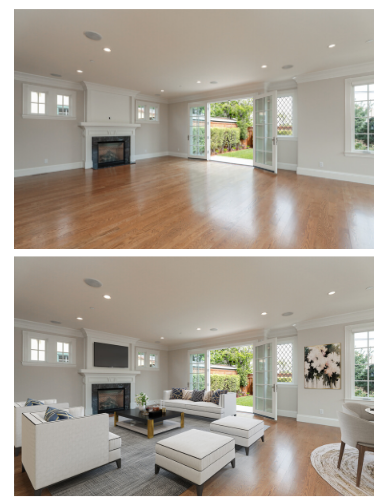Virtual staging of homes has been around for years, but in post COVID-19 times, most real estate professionals across the globe agree that virtual staging’s popularity will continue to skyrocket.
“I believe the virtual staging experience will evolve as the market transitions,” said Dan Rider, real estate agent in Reno, Nevada, with Nevada Home Connections. “I haven’t had a lot of experience personally with virtual staging, but I suspect I will in the future.”
Rider says in the past when he’s taken clients into properties that they had seen virtually staged, clients were sometimes disappointed when faced with the reality of the property.
However, he suspects that virtual staging will become more the norm due to changes in the industry brought about by COVID-19 and health and safety regulations.
Young J. Kim, CEO of Bella Staging based in Vancouver, British Columbia, says that virtual staging was coming into its own even before COVID-19, but the pandemic has increased his business significantly. In April, he hired four new designers to meet the growing demand.
“People had heard of virtual staging but the quarantine gave people a new reason to try virtual staging,” Kim said. “We’re getting three times the orders we were getting before COVID.”
Kim says all indications show that the new clientele has been pleasantly surprised with the results.
 “One issue before was that the furniture didn’t look realistic. Now, we have developed techniques to make the furniture look real,” Kim said. “We incorporate shadows, reflections, Photoshop, 3-d modeling. We’re able to achieve amazing results.”
“One issue before was that the furniture didn’t look realistic. Now, we have developed techniques to make the furniture look real,” Kim said. “We incorporate shadows, reflections, Photoshop, 3-d modeling. We’re able to achieve amazing results.”
Kim’s company, Bella Staging, offers three services — general staging of an empty room, furniture removal and staging and then, finally, virtual renovation.
“With the third option, we go in and renovate the room. We change counter tops. We put in a new backsplash. We show prospective home owners the potential the space has,” Kim said.
Lighting, reflections, shadows make a big difference in virtual staging, according to Kim.
“People like our work. It usually comes down to the small details — reflections in the window or mirror, a shadow beside a chair. We even make the furniture reflect in the window. In virtual staging, attention to detail makes all the difference.”
Blair Broussard, a real estate with District South Real Estate, based in Lafayette, Louisiana, said she’s seen the results and advantages virtual staging offers.
“It’s a good alternative for sellers who don’t have a budget to stage a space in the traditional way,” Broussard said. “People get to see a home in the best light possible, and then I have to manage the potential homeowners’ expectations.”
Broussard says real estate professionals will have their work cut out for them in the coming months to educating prospective home owners and sellers to the wonders virtual staging offers.
“We have to prepare buyers that the room does not look like this in person, but the bones are there — and it has the potential to look like this.”
Broussard says she’s careful not to mislead clients but especially appreciates the way virtual staging shows people how quirky spaces could function.
“Sometimes in an empty room, potential home buyers struggle to see the possibilities. Virtual staging gives them ideas, especially in how to use rooms that have unusual configurations,” she said, recounting a particular nook in a home that she had virtually staged. “The designer made the nook into a space for the family dog. It was cute and just opened up the possibilities for prospective buyers.”
Broussard says the economic advantages of virtual staging is another win for people trying to sell on a budget or even those who are pressed for time.
“It’s more financially friendly than traditional staging,” Broussard said. “For sellers in a financial crunch, virtual staging offers the buyer a better visual.”







